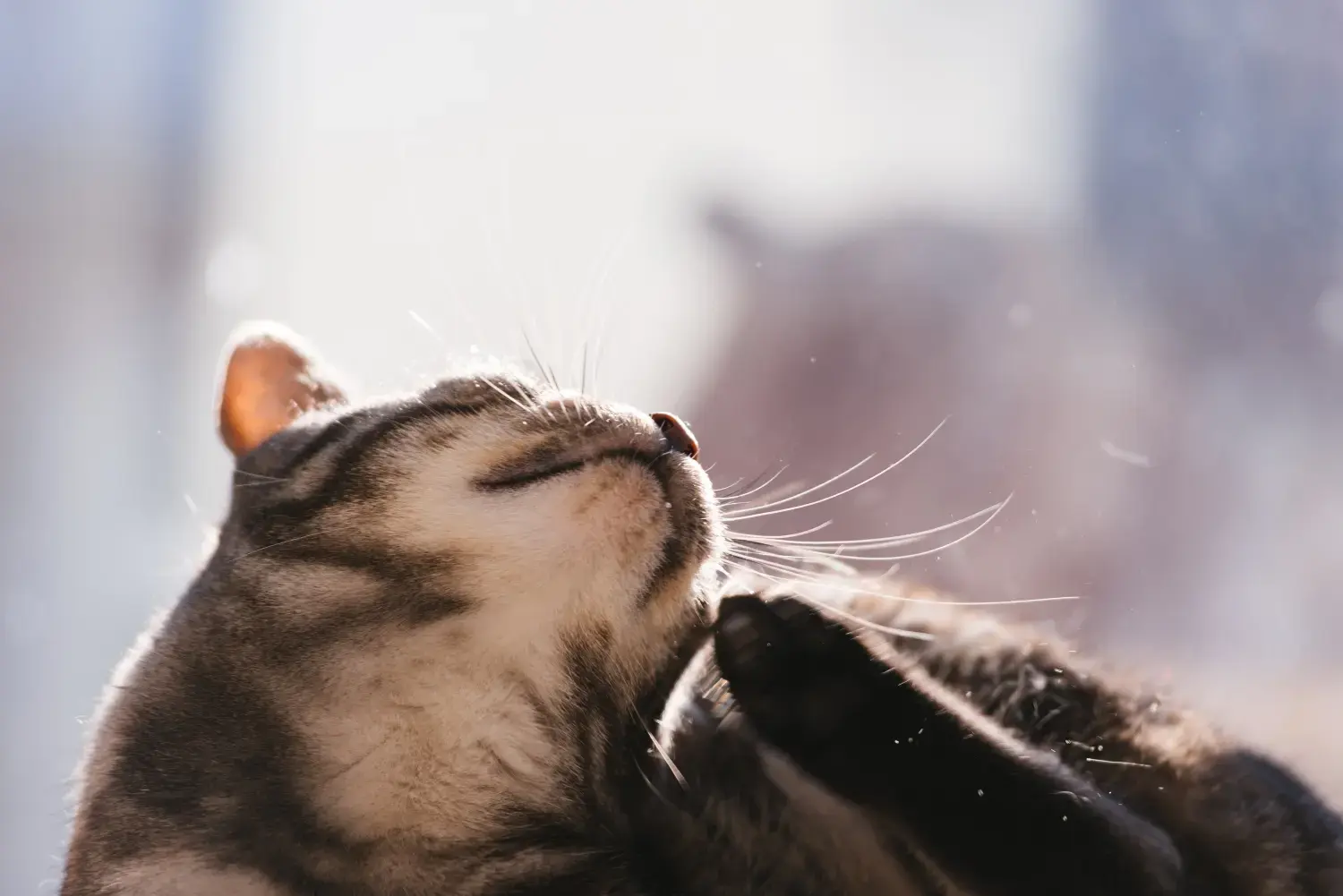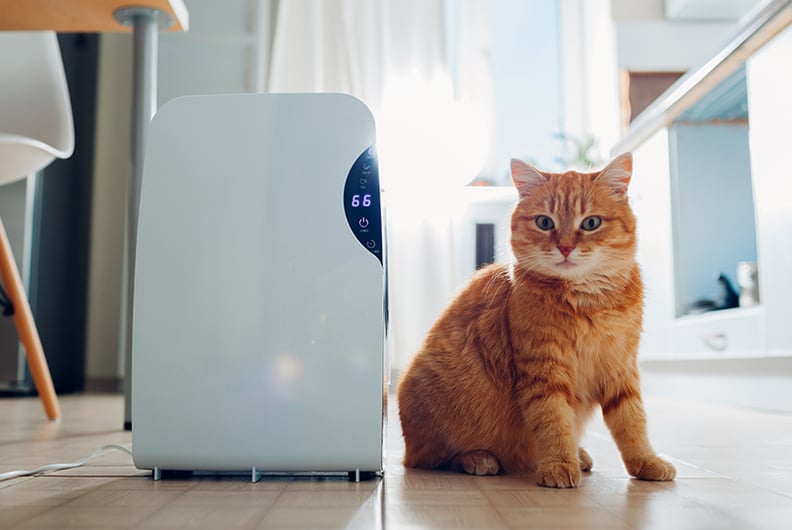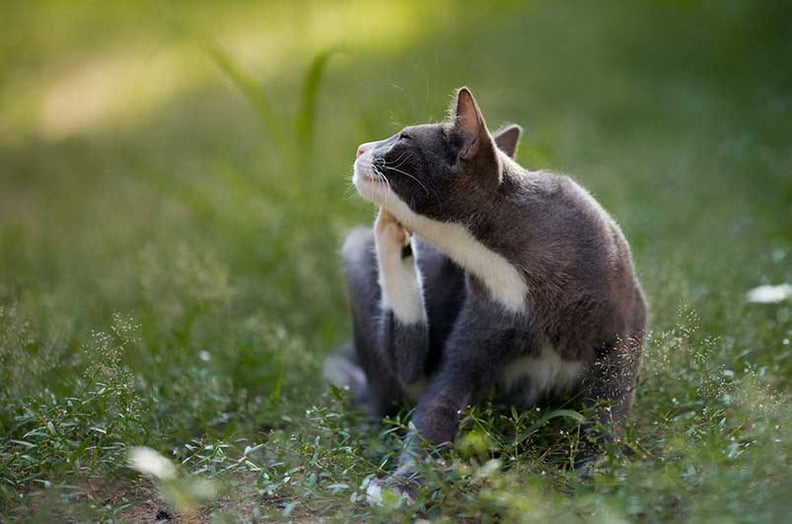
Does your cat have a bad case of cat dandruff? Dandruff, skin infections, and dry skin problems can leave your cat feeling itchy and uncomfortable.
As it turns out, cat dry skin dandruff is persistent and can lead to more serious skin problems if you don't find the cause and treat it. Your cat's delicate skin (all over the cat's entire body) can be affected by a variety of internal and external factors, so no one cat dandruff treatment will work for treating all cat dandruff.
What is Cat Dandruff?

To help you rid your cat of dry, flaky skin problems, we first need to look at what it is. So, what is feline dandruff?
What we often refer to as dandruff in cats is simply patches of dry skin. Dry skin tends to be itchy but will not produce the same extreme symptoms as Seborrhea if treated properly. Further problems can be caused by your kitty scratching, licking, or over-grooming the areas to try to soothe the itch and discomfort.
Why Does My Cat Have Dandruff?
There is no one cause of dandruff in cats, so finding the root cause for your cat's flaky skin may require a little bit of trial and error.
So what is causing your cat's skin irritation?
-
- Poor Quality Diet
- Dehydration
- Pollutants
- Food Allergies
- Over Bathing
- Bug Bites
- Illness or Disease
How to Get Rid of Cat Dandruff
To help reduce symptoms and lessen discomfort, there are some things you can do from home to help treat your feline's dandruff, even if they regularly suffer infections.
Let's look at the most common ways to treat dandruff.
1. Moisturize - Inside and Out

When dealing with any type of dry and rough skin, it's always more effective to treat the areas of concern from the inside out. Cats notoriously drink very little water compared to what they need.
In the wild, cats would get most of their moisture from cat food, such as raw cat food. As many domesticated cats eat dry kibble diets, it's common for them to live in a state of mild dehydration for a long time. Luckily, simply adding water to your furry friend's diet is one of the main cat dandruff solutions.
Solution
You can try encouraging them to drink more by switching from a boring old water dish to a filtered fountain. Check out all the benefits of Cat Water Fountains. Ample water can also prevent kidney disease.
Try incorporating wet cat food, switch to a raw diet, or add water.
2. Choose a Natural and Balanced Cat Diet

The quality of your cat's food can have a drastic effect on how their bodies are able to digest and use nutrients. Poor quality foods, foods cooked at extreme temperatures, and those that use heavily rendered ingredients offer limited nutrition compared to whole, natural, and minimally processed ingredients.
Solution
Look for foods that use fresh, real food ingredients. Choosing a diet that is natural, complete and balanced will keep your cat's skin and coat healthier. So what is the best cat food for dandruff?
Raw is a great example of a high-quality diet that offers highly digestible nutrients to support all the systems in your cat's body. Wet cat food is also a great choice to relieve itchy skin and keep the cat hydrated.
If raw isn't your thing, then look for foods that limit synthetic additives, and offer nutrition from nutrient-dense ingredients like fresh meats, organs, and produce. Try to avoid carb-heavy diets for obese cats. After all, they are carnivores and are best at getting nutrients from animal protein.
Pet owners should ensure their pet maintains a healthy weight so their cat does not experience walking dandruff or develop dandruff from dehydration.
Here are a few of our favourite natural brands for cats to maintain a proper diet:
3. Appropriate Cat Grooming Habits

Cats are generally meticulous groomers, but your cat's ability to groom might fall short, so you can help by brushing your kitty regularly.
Brushing your cat regularly helps to remove dead fur, white flakes and dry skin. Regular brushing also massages the skin, stimulates blood flow, prevents skin lesions, relieves allergy symptoms, and encourages appropriate oil production from their sebaceous glands.
Bathing is required much less frequently in overweight cats than in dogs. This is partly because dogs often don't mind being a little dirty but also because cats have more sensitive skin.
Overbathing your cat can limit healthy oil production and alter its skin's pH balance.
Solution
Most cats enjoy being brushed, so it's often a quick and stress-free routine. Try to brush your furry companion a couple of times per week with a simple slicker brush for the best results.
Practicing good grooming practices can improve skin conditions and remove any allergies causing dandruff.
Avoid bathing your feline too frequently, which can make the skin condition worse. Aim for no more than once every 6 weeks unless it's necessary. If your cat objects to bathing, then remember it's completely normal.
4. Appropriate Humidity & Environment

Cats are very sensitive to their environments. Skin and coat issues are often exacerbated by chemicals and poor air quality. They can also be affected by extreme climates, like hot or dry places, so you need to consider what type of environment you provide your cat.
Solution
Avoid using harsh chemicals around your kitty, and make sure your house is well-ventilated. An air purifier is an excellent option for small spaces, especially over winter when our windows stay closed 24/7.
If your home is very dry, then look at getting a humidifier to help put some moisture back into your cat's environment and improve the skin.
5. Pest Prevention

Your cat's dandruff might not be related to its health at all. Talk to your vet to make sure your cat isn't being plagued by some unwelcome intruders that are causing her skin issues.
External parasites frequently led to dandruff and require medical treatment. Fleas and ticks are the most common pests and the easiest to spot. Talk to your vet to help identify pest activity at the earliest signs. Veterinary medicine is often a great way to not only control parasites but also overcome any underlying health conditions.
Other pests you should talk to your vet about include lice and mites, which lead to irritated skin. The good news is you can easily protect your pets from most of these pests with products like Elanco Advantage II.
Flea control products and topical treatments are often a great way to control pets, prevent any underlying health condition problems, stop scaly patches and control existing dandruff.
Solution
It's important to regularly check your cat's coat for signs of infestation. Routine cat grooming and regular vet check-ups can help you catch problems early and treat them quickly. Be preventative when it comes to pests.
4 Natural Home Remedies for Cat Dandruff
When it comes to cat dandruff treatment, you should always start by identifying the cause, but once you know the reason for your cat's dandruff, you can start to treat the symptoms so your furry friend can heal faster and stay comfortable.
Here are some of our top natural solutions for treating the symptoms of dandruff on a companion:
#1. Thrive, Silver Shield,
Colloidal silver is a natural anti-fungal and anti-microbial to help reduce itch and support healing. Thrive Silver Shield is a quick and easy topical spray to treat itch and irritation.
#2. Baie Run Coconut Oil
Another natural anti-fungal treatment for your cat's skin is coconut oil. Baie Run Coconut Oil is made from organic, cold-pressed coconut oil for a pure and natural topical solution for your cat's dry skin health.
#3. Adored Beast Apothecary Love Bugs
Digestion is the core of your cat's health, so maintaining a good balance of healthy bacteria in your cat's gut is a great way to keep her skin healthy from the inside out. Love Bugs is a blend of pre and probiotics to support digestion and overall health.
#4. Skout's Honor Probiotic Itch Relief Spray
To handle the aggravating itch that comes along with dry cat skin health and cat dandruff, Skout's Honor Probiotic Itch Relief Spray uses healthy bacteria to counteract the bacteria that is driving your kitty nuts.
Frequently Asked Questions About Dandruff in Cats
What are the signs of cat dandruff?
Signs of cat dandruff include the presence of white or flaky particles on your cat's fur and bedding.
Can dandruff be a symptom of an underlying health problem?
Yes, dandruff can be a symptom of various health issues such as allergies, flea infestations, ringworms, or even more serious conditions like thyroid problems. Cutaneous lymphoma often mimics dandruff.
How can I prevent cat dandruff?
Regular grooming is key to preventing dandruff. Brush your cat's fur regularly to distribute natural oils and remove dead skin cells. Providing a well-balanced diet with essential fatty acids and proper hydration can also prevent dandruff from forming.
Can I use human dandruff shampoos on my cat?
It's not recommended to use human dandruff shampoos on cats. These shampoos may contain ingredients that are not safe for felines.
What is the best cat food for dandruff?
Stick to natural and well-balanced diets like raw cat food are a great option to help support skin and coat health as well as the immune system. High-quality, meat-rich, and natural cat kibble and wet diets are also good options.
Is cat dandruff common in older cats?
Yes, older cats are more prone to developing dandruff due to changes in their skin's oil production and metabolism.
Should I be concerned if my cat has occasional dandruff?
Occasional dandruff might not be a cause for concern, especially if your cat is healthy. Persistent dry, flaky, and itchy skin warrants some further investigation.
.png?width=200&height=66&name=logo%20(1).png)




.jpg)
